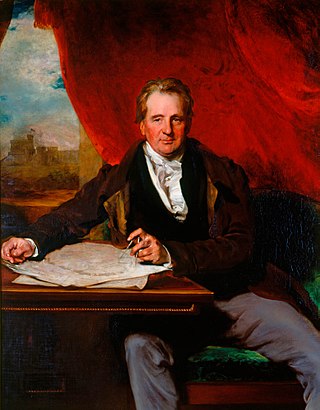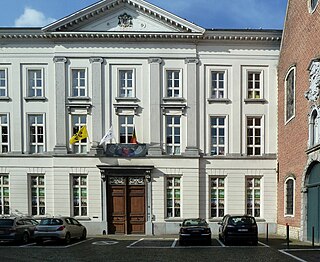Related Research Articles

Roeselare is a Belgian city and municipality in the Flemish province of West Flanders. The municipality comprises the city of Roeselare proper and the towns of Beveren, Oekene and Rumbeke.

Guido Pieter Theodorus Josephus Gezelle was an influential writer and poet and a Roman Catholic priest from Belgium. He is famous for the use of the West Flemish dialect.

The Walhalla is a hall of fame that honours laudable and distinguished people in German history – "politicians, sovereigns, scientists and artists of the German tongue"; thus the celebrities honoured are drawn from Greater Germany, a wider area than today's Germany, and even as far away as Britain in the case of several Anglo-Saxon figures. The hall is a neo-classical building above the Danube River, in Donaustauf, east of Regensburg in Bavaria.
The Düsseldorf school of painting is a term referring to a group of painters who taught or studied at the Düsseldorf Academy roughly between 1819 and 1918, first directed by the painter Wilhelm von Schadow.

Albertus "Albrecht" Petrus Josephus Mansuetus Ferdinandus Rodenbach was a Flemish poet, and a leader in the revival of Flemish literature that occurred in the late 19th century. He is more noteworthy as a symbol of the Flemish movement, than for his actual activities, since he died at the age of 23. Hugo Verriest called Rodenbach the poet, the soul, the heart, the mind, the word of Reborn Flanders!

Jules Lagae was a Belgian sculptor and medallist, born in Roeselare.

Sir Jeffry Wyatville was an English architect and garden designer. Born Jeffry Wyatt into an established dynasty of architects, in 1824 he was allowed by King George IV to change his surname to Wyatville. He is mainly remembered for making alterations and extensions to Chatsworth House and Windsor Castle.

The Saint Petersburg Theological Academy is a theological seminary in Saint Petersburg, Russia. The academy grants master and doctorate degrees preparing theologians and priests for the Eastern Orthodox Church. It was founded in 1797 by Gabriel (Petrov), Metropolitan of Saint Petersburg, as part of the Alexander Nevsky Lavra.
Henry Herbert Southey M.D. (1784–1865) was an English physician.

The Maatschappij tot Nut van 't Algemeen is a non-profit organization in the Netherlands founded in 1784 with the purpose of developing individuals and society, primarily through education. It had great influence in improving public education through better textbooks, model schools and teacher's training. The society continues to be involved in extracurricular education.

St. Joseph Minor Seminary is a Catholic secondary school in Sint-Niklaas, Diocese of Ghent, Belgium. There were previously a Recollect monastery and a seminary on the site.
Joost M. A. Caen is a Flemish independent artist and glass conservator since 1982. In his workshop, he creates contemporary stained-glass windows for churches and secular buildings. In 2003 he was one of the first stained-glass artists who incorporate solar cells into a glass creation. This work can be seen in the entrance hall of the District House at Deurne, Belgium. Caen also conserves stained-glass panels and windows, mainly for museums and collectors.

Jan Frans van de Velde (1779–1838) was the 20th bishop of Ghent, in Belgium, from November 1829 until his death.
Pol Demade (1863–1936) was a Belgian writer who also published under the pen name Jean Suis.
Joseph Jean De Smet (1794–1877) was a priest and historian who took part in the Belgian Revolution of 1830.
References
- 1 2 3 4 "Klein Seminarie en kerk". erfgoed.net. Flanders Heritage Agency.
- 1 2 3 Hugo Cammaer; Melisa Ventriglia (30 July 2019). "Klein Seminarie, Roeselare (1806-1812; 1814-1825; 1830-heden)". ODIS.